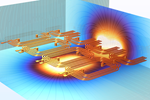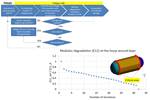Comsol releases version 6.2 of Comsol Multiphysics software
Latest version of comprehensive simulation software speeds up computations and introduces surrogate model functionality.
Turbulent flow simulations are now up to 40% faster, showcased here by high-Mach-number flow through a ramjet nozzle. Photo credit, all images: Comsol
Simulation software provider (Burlington, Mass., U.S.) has released version 6.2 of Comsol Multiphysics, a software is well-suited to . The company has added data-driven surrogate model functionality for efficient standalone simulation apps and multiphysics-based digital twins. The updated version also features high-performance multiphysics solvers for the analysis of electric motors, up to 40% faster turbulent CFD simulations and an order of magnitude faster impulse response calculations for room and cabin acoustics. Additionally, it is able to more rapidly perform boundary element analysis (BEM) for acoustics and electromagnetics when running on clusters.
Surrogate models deliver accurate simulation results faster than the full-fledged finite element models that they approximate, Comsol explains. When used in simulation apps, this leads to near-instantaneous results, providing app users with an improved interactive experience. In addition, surrogate models are useful for digital twins, where fast and frequent updates of simulation results are often necessary.
The latest software version also introduces the ability to make simulation apps with automated updates through timer events, which is especially useful when creating digital twins or IoT-connected simulation apps.
The boundary element method, used here for a radar cross section computation, is now up to seven times faster.
Version 6.2 expands the capabilities for efficient simulation of electric motors as well as for transformers and other electric machinery through a time periodic solver, available in the AC/DC Module. It also enables multiphysics motor analysis involving acoustics, structural mechanics, multibody dynamics and heat transfer, and makes it possible to run optimization studies to find new motor designs. More efficient analysis of multiphysics phenomena “is pivotal for electric motor design optimization, where a balance between structural, thermal, and electromagnetic objectives is essential,” notes Durk de Vries, technical product manager for the AC/DC Module at Comsol.
Users will also discover new modeling features across the board. Core offerings, like visualization and meshing, are improved, and add-on products are expanded and updated. Version 6.2 also adds more than 100 new and updated example models, helping users enhance their modeling skills.
Some highlights from the broadened scope of physics modeling include:
- Seven turbulence models for high-Mach-number flow.
- Realistic frequency-dependent materials for acoustics simulations in the time domain.
- Modeling of hydrogen embrittlement in solids for fuel cells, electrolyzers and corrosion.
- Extended damage, fracture and contact modeling.
- Easy-to-use specific absorption computations for RF tissue simulations.
- Analysis of light propagation through liquid crystals.
- Ability to use local weather data for temperature and pressure in simulations, based on a GPS location.
To get an in-depth look at the latest version, browse the . Alternatively, for an introduction to Comsol Multiphysics and a look at how the updates have enhanced its overall power check out the company’s .
Subscribing users can download the .
Related Content
-
NCC leads composites manufacturing phase of eXtra wing demonstrator
Key structural elements for a 6-meter section of the Airbus biomimetic wing were undertaken by NCC engineering specialists to produce 28 one-off flying parts.
-
Aurora reveals latest SPRINT X-Plane design concept
An Aurora and Boeing team advances its high-speed, vertical lift concept to the preliminary design phase, which features three lift fans, a more refined composite exterior and an uncrewed cockpit.
-
Carbon fiber, bionic design achieve peak performance in race-ready production vehicle
Porsche worked with Action Composites to design and manufacture an innovative carbon fiber safety cage option to lightweight one of its series race vehicles, built in a one-shot compression molding process.






